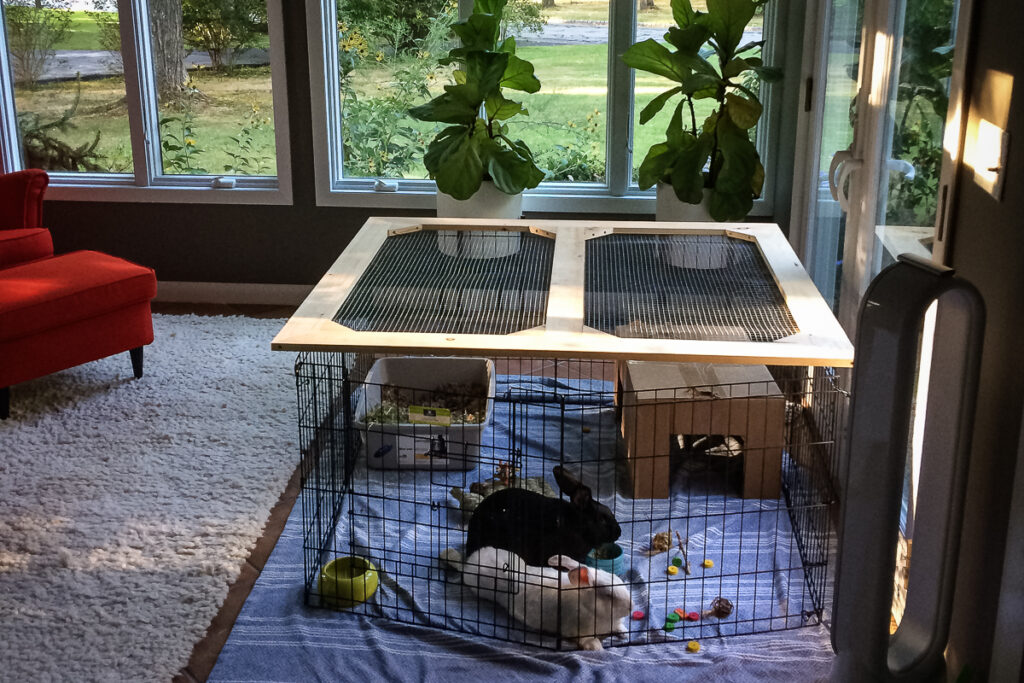Would anybody like to know how we kept the living areas clean for the 64 resident rabbits and 15 boarding rabbits at The Rabbit Center? In browsing through our recently updated shelter manual, it occurred to me that some of our “best practices” for giving multiple animals the best care possible, while they await adoption, might be useful for other rabbit rescues or individuals with already-adoped bunnies in their own homes. Let’s try a few procedures that might fit for you.
ORGANIZING SUPPLIES
You may not have several bunny rooms, but the recommendations for cleaning our adoptable bunnies’ habitat rooms can certainly be used for single rooms or smaller areas. An essential time-saving device used is a utility cart. These are quite handy for bringing supplies to habitat areas of any size, as well as carrying them away. Basically, you are carrying in the clean supplies, all at once, and carrying out the dirty ones.
Your cart can be parked in the area where you store your bulky litter supplies, such as a laundry room or service porch.
LOADING LITTERBOXES
The items listed in the photo should be added to the cart before you wheel it off to the bunny station.
Have you ever thought of using a “redundant” system? It’s great for saving you steps. Each rabbit space has two litterboxes, assigned by numbers. A fresh box replaces a used one on alternating days.
Start with clean litterboxes in the cart-loading area. Distribute a thin layer of litter in the bottom of the box and cover with 1″ grass hay. Stack the litterboxes on the cart, along with the other items and you’re ready to go.
Keep a broom, whisk broom, and a dustpan in the habitat area as part of the furnishings. Depending on your space, you might also keep your hay in a large bin in the habitat area and load the hay after you get there with the litterboxes.
HABITAT CLEANUP
These are the steps used at the Rabbit Center, which could be adapted to use at another rescue or in your home.
- Let bunny out to run into the hallway
- Shake out bunny’s sitting rug. If wet or soiled drop it into the plastic bag on the cart.
- Sweep habitat floor. Dump floor sweepings into dirty litterboxes.
- Remove soiled litterboxes.
- Spot clean stains with the vinegar spray; then dry with paper towels.
- Replace soiled rugs.
- Dump water bowls into pail.
- Rinse and fill water bowls from jug.
- Feeding can be done at this time (if that fits your schedule)
CLEANING BOXES AND LINENS
These guidelines work no matter how many or how few litterboxes you are cleaning. Each day the cages and litterboxes should be checked to see if they need to be totally cleaned or just refreshed. If the box isn’t too dirty, just top it off with hay. Make sure that any surface hay, which is available for bunny’s consumption is clean and dry.
Load dirty litterboxes and the bag of soiled linens onto the cart and wheel it back to your cleanup area.
Soiled litter is dumped in a plastic-lined trash barrel. When the barrel is 1/3 full, start another plastic bag on top so that the bags are not too heavy to lift.
Wash the litterboxes with vinegar in a sink or tub or at an outside faucet. Use a scrub brush if necessary. Rinse and stack the litterboxes to air dry on racks.
ROOM TASK SHEET
The Rabbit Center shelter manual also includes the following instructions:
“Each rabbit room (Quarantine, Habitats A-D, and the Boarding room) has a task sheet in it. Please just mark off, at the end of the day, the cages/pens and litterboxes you’ve cleaned so that the supervisor the next day will know what to do that day.”
You may not feel that a task sheet is necessary if you are the only one doing the tasks. However, there are times that you may be preoccupied, and I know from experience that it may sometimes be hard to remember what you have already done. Also, a well-organized task list is a valuable aid, if you ever need the services of a pet sitter.
QUARANTINE
All incoming bunnies are assigned to a quarantine space for three weeks to prevent or reduce the possibility of an undetected disease infecting other rabbits. During this time they receive a veterinary health screening, and their information is entered into the database. A spay/neuter appointment is scheduled. If these things have not already been done by the shelter you adopted your bunny from, and if you have other bunnies in your house, then you need to follow these steps on your own. After the quarantine period has ended and your new bunny has recovered from the spay/neuter surgery, he/she can be introduced to other bunnies in your household, depending on compatibility.
Another way quarantine might be useful in your own home is to prevent a disease outbreak among multiple rabbits. We don’t normally separate bonded bunnies when one of them is sick (assuming that the companions have already been exposed and that separation would add to the stress). If you have several pairs of rabbits, however, you can set up mini-quarantine areas among the groups. You can minimize shared air space by using solid partition between habitats. That will help keep rabbits with respiratory disease from sneezing into air that is inhaled by rabbits from other groups.
The Rabbit Center shelter manual states:
“Litterboxes may also contain pathogens (harmful bacteria, protozoa, viruses or parasites, such as mites, flea eggs, coccidia and pinworms). Hopefully, these are contained within the litterbox, but when dumping the box, dust from it may become airborne. Once in the air, pathogens may settle in another rabbit’s cage or on your clothes or on the floor. You may carry these pathogens out on your shoes.”
Be aware of this potential when you have a mixed group of healthy and sick bunnies in your household. Clean the healthy bunnies’ spaces before working with the sick bunnies. Dump the sick bunnies boxes in a different room and mop the floor after the dust has settled.
To reduce exposure, wear an apron or smock over your clothing and keep a separate set of basic items (broom, whiskbroom, dustpan, paper towels) for the sick room. Also, keep a spray bottle of disinfectant and a hand sanitizer in the area. Use the hand sanitizer after handling each rabbit. Other materials can be assembled on the cart the same procedure followed as for the healthy bunny habitats.
You may not always need to take such hospital-like precautions in your own home, but if you have bunnies with contagious diseases, these are a few things you can do to reduce the risk to your other bunnies. Most of the time all you need is a reasonable household cleanliness, and your bunnies can all enjoy each other’s company.

